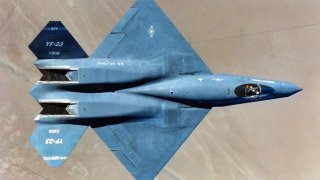YF-23: Would Japan Build the Stealth Fighter Some Say Is Better Than F-22?
It is unclear whether the Japanese military would opt for a modernized version of the YF-23 for its new stealth fighter jet. Tokyo has also been working with other countries on a potential 6th generation stealth fighter jet. Only time will tell whether the YF-23 makes a surprise return.
The YF-23 Black Widow is one of the most fascinating aircraft that never came to be.
Manufactured by Northrup Grumman and McDonnel Douglas, the YF-23 was a single seat, stealth fighter jet that competed for the Air Force’s Advanced Tactical Fighter program.
Although the aircraft eventually lost to Lockheed Martin’s YF-22, which became the F-22 Raptor stealth fighter jet, the YF-23 has remained in the news.
Throughout the years, Japan has maintained an active interest in the stealth fighter jet.
The YF-23 Black Widow, Explained
With diamond-shaped wings, the YF-23 Black Widow came very close to being the Air Force’s and the world’s first stealth fighter jet.
Although it lost to the F-22 Raptor, the YF-23 Black Widow brought some impressive characteristics to the table.
In terms of performance, the YF-23 could reach speeds of up to Mach 2.2 (almost 1,700 miles per hour) and had a notional range of approximately 2,500 miles (but a combat radius of about 800 miles).
As far as weapon systems, the YF-23 could potentially carry up to 10,000 lbs of munitions, including an internal M61 Vulcan 20mm cannon, AIM-9 Sidewinder heat-seeking air-to-air missiles, and AIM-120 Advanced Medium-Range Air-to-Air Missile (AMRAAM), as well as smart munitions.
Interestingly, the YF-23 was both stealthier and faster than its competitor. But it wasn’t as agile as the F-22, and that eventually dinged it.
Visitors to the National Museum of the United States Air Force can see a fully restored YF-23 at the museum’s research and development hangar.
Japan, the F-22 Raptor, and the YF-23
The Japanese military has had a long love affair with stealth fighter jets. For years, Tokyo tried to get Congress to approve a foreign military sale of the F-22 Raptor. With the threat of North Korea and China, the Japanese air force wanted to bolster its air superiority capabilities.
Congress eventually decided not to go forward with such a sale for two reasons. First, to ensure that the stealth fighter jet’s classified technology remained secure. Second, to ensure that the balance of power in the Indo-Pacific remained constant—China didn’t present the same national security threat it does today and the Global War on Terror (GWOT) was demanding the Pentagon’s and Congress’ attention.
As such, the Japanese air force moved ahead with its own plans for a stealth fighter jet. Eventually, Tokyo entered the F-35 Joint Fighter Program and today operates both F-35A and F-35B Lighting II stealth fighter jets (order for 105 F-35As and 42 F-35Bs). But the Japanese military is still looking for another stealth aircraft for the future. Northrup Grumman has shown active interest in being part of such a program, even with an updated version of the YF-23, with reports mentioning this possibility on and off throughout the years.
It is unclear whether the Japanese military would opt for a modernized version of the YF-23 for its new stealth fighter jet. Tokyo has also been working with other countries on a potential 6th generation stealth fighter jet. Only time will tell whether the YF-23 makes a surprise return.
About the Author
Stavros Atlamazoglou is a seasoned defense and national security journalist specializing in special operations. A Hellenic Army veteran (national service with the 575th Marine Battalion and Army HQ), he holds a BA from the Johns Hopkins University, an MA from the Johns Hopkins’ School of Advanced International Studies (SAIS). He is pursuing a J.D. at Boston College Law School. His work has been featured in Business Insider, Sandboxx, and SOFREP.


